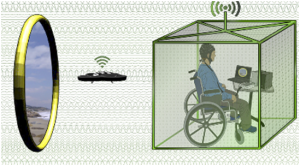FLYING A DRONE WITH YOUR BRAIN
June 12, 2013
 Researchers in the University of Minnesota’s College of Science and Engineering have developed a new system that allows people to control a flying robot using only their mind. The study was published today in IOP Publishing’s Journal of Neural Engineering. Five subjects (three female and two male) who took part in the study were each able to successfully control the four-blade flying robot, also known as a quadrocopter, quickly and accurately for a sustained amount of time.
Researchers in the University of Minnesota’s College of Science and Engineering have developed a new system that allows people to control a flying robot using only their mind. The study was published today in IOP Publishing’s Journal of Neural Engineering. Five subjects (three female and two male) who took part in the study were each able to successfully control the four-blade flying robot, also known as a quadrocopter, quickly and accurately for a sustained amount of time.
The research is intended to help people who are paralyzed or have neurodegenerative diseases regain mobility and independence. The researchers envision that they’ll use this technology to control wheelchairs, artificial limbs or other devices, It may even help patients with conditions like autism or Alzheimer’s disease or help stroke victims recover. They’re now studying some stroke patients to see if it’ll help rewire brain circuits to bypass damaged areas.
Nobody has to have a chip implanted in their brain to pick up the neuronal activity. The technique is ” noninvasive” and is called electroencephalography (EEG). It’s a a unique brain-computer interface that records electrical activity of the subjects’ brain through a specialized, high-tech EEG cap fitted with 64 electrodes. If you want to read more about it, here’s where you can download the research paper. http://iopscience.iop.org/1741-2552/10/4/046003/pdf/1741-2552_10_4_046003.pdf
The researchers said the brain-computer interface system works due to the geography of the motor cortex—the area of the cerebrum that governs movement. When we move, or think about a movement, neurons in the motor cortex produce tiny electric currents. Thinking about a different movement activates a new assortment of neurons. Sorting out these assortments laid the groundwork for the brain-computer interface used by the University of Minnesota researchers,

 English | EN
English | EN 